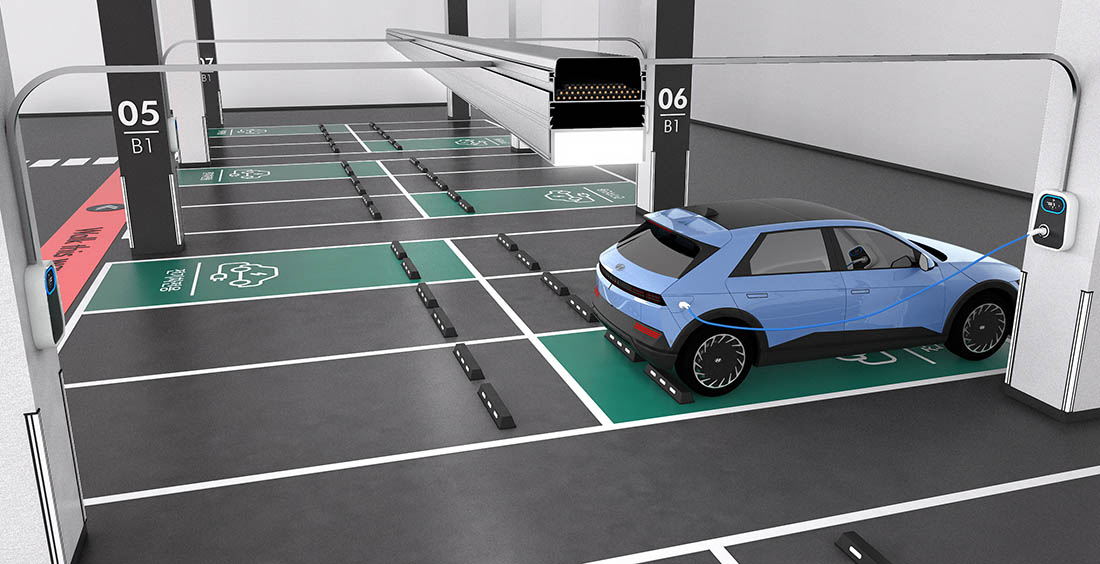Press Release
Hyundai E&C applies smart EV charging solution to apartment buildings for the first time
▲ Hyundai E&C designs and deploys smart charging solutions to meet future EV demand
… It creates a foundation for additional EV chargers and power management through the use of wide cable ducts and smart switchboards
… It is expected to see improved space efficiency, more stable power management and cost savings when chargers are added after residents move in
▲ The builder will take the lead in creating a differentiated residential environment through its smart home service connected to the building infrastructure
… Driver convenience will be enhanced with the real-time charger finder service using the smart home platform
… The builder plans to provide convenient EV user experience by expanding charging services and diversifying charging methods

[ Smart charging solution of Hyundai E&C. EV chargers are installed using wide cable ducts located under the ceiling of parking spots ]
In order to take the lead in the era of mass adoption of electric vehicles, Hyundai E&C takes serious action by creating a smart solution.
Hyundai E&C makes and applies an integrated solution to allow apartment buildings to add EV charging infrastructure without restrictions. In line with the trend of expanding electric vehicles and chargers, the builder decided to come up with future-proof plans to design and construct apartment complex, so that EV chargers can be added even after the builder completes the construction and residents move in.
The number of registered EVs in Korea has already reached 550,000 (as of the end of 2023), and the era of mass adoption of EVs is expected to accelerate as more than 1.23 million chargers will be installed according to the EV expansion policy targeting 4.2 million EVs by 2030.
Against this backdrop, Hyundai E&C will build infrastructure in advance to expand EV charging facilities in preparation for the increased use of EVs. By installing ▲ wide cable ducts and ▲ smart switchboards in advance in parking lots of apartment buildings, the solution allows EV charging spots and zones to be added without restrictions, improving space efficiency and stable power management, while reducing residents’ cost burden when adding chargers. Hyundai E&C also plans to improve convenience for drivers through ▲ the service to find chargers in the apartment complex which will be introduced in many apartment complexes after being first introduced in THE H Daechi Edellui, which will be completed in 2025.
The ’wide cable duct’ is an improvement to the lighting duct of parking lot ceiling. The builder will use a wider mold, twice as wide as the previous one, to accommodate both lighting wires and EV charging cables. When installing EV chargers, the power cable should be connected from the public switchboard of the parking lot to the EV charger. With a wide cable duct, it is possible to add chargers anywhere without major construction work.
A “smart switchboard” is a device that detects the transformer usage of the apartment complex in real time and adjusts the power consumption of the chargers. Adding more EV chargers beyond a certain level usually requires additional construction work to get additional power from an external source. However, with smart switchboards, it is possible to feed excess power from the apartment complex to the chargers, and to adjust the power sources of some chargers when power consumption is high to flexibly respond to the limited power capacity for the EV chargers.
In addition, Hyundai E&C provides drivers with real-time information on the location of available EV chargers and EV charging spots through the “Charger Finder” service on its smart home platform. On top of this, the company plans to provide residents with a convenient EV experience by expanding the Plug and Charge (PNC) service, which completes user verification, charging and payment in one step when the charger is connected to EVs, as well as real-time charging status check and charger reservation the services.
Recently, the Hyundai Motor Group announced its goal to build 500 E-pits, an ultra-fast charging service. As Hyundai E&C makes smart EV charging solution and accelerates the era of EV based on this solution, it is expected that the synergies among the companies in the group will be expanded.
Meanwhile, Hyundai E&C has presented a new paradigm for the residential spaces by showcasing the technology interconnecting smart home with mobility for the first time among builders. For example, it developed and commercialized “Hi-oT,” a smart home system, in 2016 and also “Home-to-Car and Car-to-Home*” service in 2021 in collaboration with Hyundai Motor Group.
*A future mobility service jointly developed by Hyundai E&C and Hyundai Motor Group. The Home-to-Car service allows users can control their vehicles at home using their voice. The Car-to-Home service allows people to remotely control home IoT built-in devices from their cars.
“The company has been looking for solutions to add charging infrastructure in a variety of ways, taking into account cost efficiency and charging convenience, with the idea that infrastructure should be strengthened from the house design stage in the EV era,” said an official at Hyundai E&C. “It will lead Hyundai E&C’s differentiated housing culture by continuously expanding residential technology and service areas that reflect future lifestyle, such as changes and expansion of mobility, and increase of smart buildings.”


